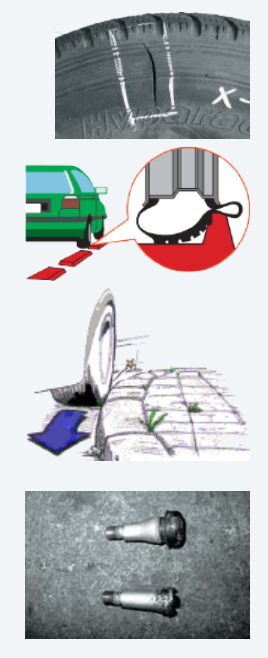Inflation pressure
Low inflation pressure may result in:
– heat separation and tire burst
– early hydroplaning
– irregular wear
– increased fuel consumption
High inflation pressure may result in:
– longer braking distance
– increased susceptibility to incisions
– decreased ride comfort
– irregular wear
Recommendations:
1. Recognize suitable inflation pressure.
2. Check and correct inflation pressure at least once a month.
Tread depth
Worn tread (shallow tread depth) may result in:
– slippage on wet surface
– hydroplaning
– decreased ride comfort
Recommendations:
1. Remove worn tires at the tread depth of 1.6mm and less and replace with new tires.
2. Check tread surface for Tread Wear Indicator showing the sign for removal.
3. Check inflation pressure with pressure gauge.
Worn tread (shallow tread depth) may result in:
– slippage on wet surface
– hydroplaning
– worsened ride comfort
Recommendations:
1. Remove worn tires at the tread depth of 1.6mm and less and replace them with new tires.
2. Check tread surface for Tread Wear Indicator showing the sign for removal.
Irregular wear
Both side shoulder rear
– The use in low inflation pressure, mostly seen on front tires.
One side shoulder wear
– Excessive alignment setting (camber, toe)
Center wear
– The use in too high inflation pressure mostly seen on tires on driven axles.
Recommendations:
1. Maintain proper inflation and check and correct wheel alignment periodically.
2. Periodic tire rotation to prevent irregular wear.
3. Avoid aggressive driving behavior, e.g. sudden steering or braking at high speed
Tire incision or cracking
Incision or cracking on tires may lead to:
– puncture or tire burst
Recommendations:
To prevent cut and cracking damage:
1. Maintain proper inflation pressure
2. Proper driving behavior and avoid colliding tire sidewall with the curb or other foreign objects.
3. Keep tires away from direct sunlight, oil, or appliances that emit ozone.
Tire deformation (bulging)
Tire bulging may lead to the separation or the rupture of tire components. There are many causes of tire bulging, such as the use of low inflation pressure, impact or curbing damage which eventually results in the separation or the rupture of tire components.
To prevent cut and cracking damage:
1. Maintain proper inflation pressure
2. Proper driving behavior and avoid colliding tire sidewall with the curb or other foreign objects.
3. Keep tires away from direct sunlight, oil, or appliances that emit ozone.
Tire valve
Deteriorated tire valve causes air leak leading to serious tire damage, such as the separation or the rupture of tire components.
Recommendations:
1. Inspect valve in case of damage including cracks.
2. Use valve cap.
3. Use new valve for new tire.
Special note
When the valve for TPMS (Tire Pressure Monitoring System) is replaced, read owner’s manual for specific instructions.





